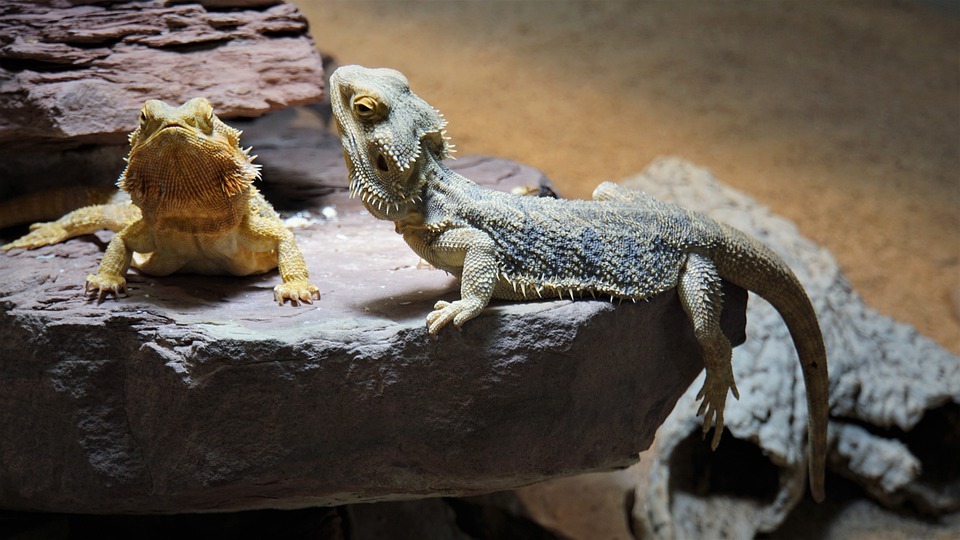Bearded dragons or also called as beardies are medium-sized reptiles that are native in Australia. They are considered good pets, and they are even suitable for beginner reptile owners. However, they do have a complex environmental and nutritional requirement. Aside from that, bearded dragons also need some time and specialized equipment to be taken care of properly. This reptile is very social, and they are straightforward to handle as well as tame. In fact, they have some fascinating behaviors which make them an interesting pet. In this article, we are going to learn more about them and find out all their basic needs.
Characteristics of Bearded Dragon
- Scientific Name: Pogona vitticeps
- Common Names: Bearded dragon, Central bearded dragon, Inland bearded dragon
- Adult Size: 16 to 24 inches long
- Life Expectancy: 6-10 years is common, but some can live up to 20 years
As we mentioned, bearded dragons are a native in Australia. They typically have brown or tan color, but some have their colors morphed, too. They got their name from the spines that grow in its throat. These spines are usually flat, but if the bearded dragon is threatened, they expand their spines up, which makes it look more like a beard. But when bearded dragons are in captivity, they are docile, and they are rarely aggressive.
Housing Bearded Dragons
If you plan to own a bearded dragon, we suggest that you put it in a 55 or 75-gallon tank that as a secure screen top cover. You can use smaller containers, but keep in mind that they will quickly outgrow them. If you are planning to own a bearded baby dragon, make sure that you will use paper towels, papers, or indoor/outdoor carpeting instead of sand because they will most likely ingest it while they are eating or when they get curious. If you have an older bearded dragon, you can use washed play sand that you can buy at hardware stores. Keep in mind that you should not use corn cob, wood shavings, walnut shells, or other substances that could cause harm if swallowed.
Bearded dragons are semi-arboreal reptiles, and they like to go to higher grounds from time to time. That is why you should provide them some sturdy rocks, branches, and half logs for them to climb on. Put it on the spot they usually bask on. You should also give them some hiding spaces to escape into. Bearded dragons need enough space to keep them healthy, that is why using high-quality and well-designed bearded dragon enclosures is recommended.
Heat and Lighting
Bearded dragons need to be exposed to UVB and UVA radiation, and you can give it to them by installing special fluorescent bulbs you can buy at pet stores. Keep in mind that bearded dragons should be at least 12 inches away from these lights for them to fully benefit from the UV that it emits. You should also put your bearded dragon’s tank in a place where it is exposed to sunlight but make sure they also have some shade and shelter that they can hide into whenever they are taking a break from basking and prevent them from overheating.
You can give them heating by installing a ceramic heater or a incandescent light and make sure that their tank should have a temperature of 80 to 85 degrees Fahrenheit on the cool side and 95 to 105 degrees Fahrenheit on their basking spot. You can use thermometers in order to keep track of the tank’s temperature. You should also give them a consistent light and dark cycle, which is usually 12 to 14 hours of daylight.
Food and Water of Bearded Dragons
When bearded dragons are in the wild, they are omnivores, which means they eat vertebrate and invertebrate insects, plants, and smaller animals. When they are in captivity, experts say that you should feed them a variety of insects such as crickets, other cultured insect prey, and vegetables, too.
You should give your bearded dragon a shallow dish full of water. You can mist your bearded dragon from time to tome but make sure that they stay in a humid environment. Adult bearded dragons typically eat silkworms, waxworms, red worms, butter worms, and earthworms. You can also give them pinkie mice, but keep in mind that you should only offer it to them occasionally.
Aside from eating insects and smaller animals, bearded dragons in captivity should also be fed with fruits, vegetables, and leafy greens.

